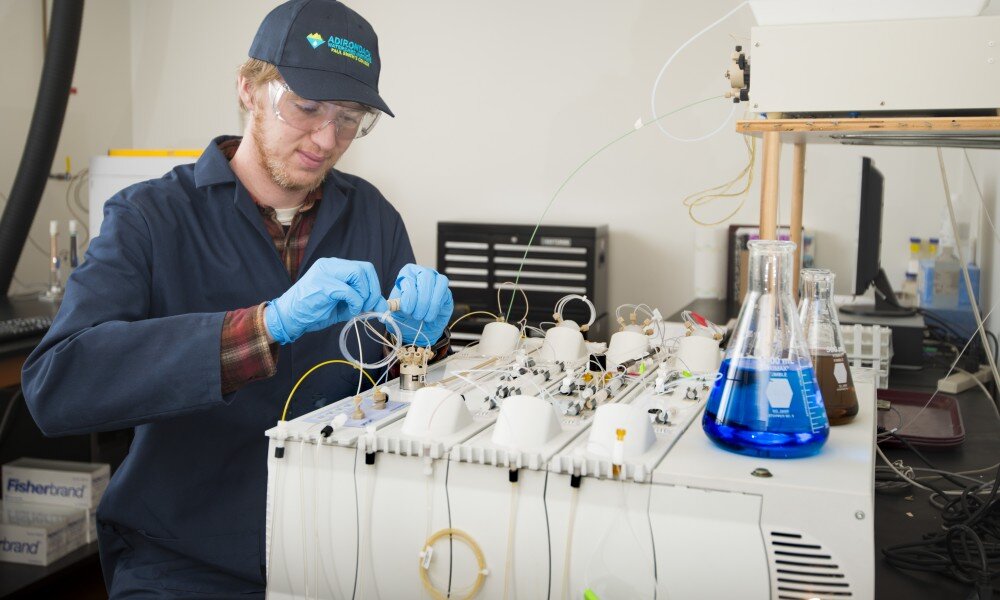
Science
Our research program is diverse and reflects ongoing needs for new science coupled with the interests and expertise of the AWI Team. We conduct a combination of fundamental and applied research, with all of our research efforts rooted in practical needs for science to inform and support policies and management to conserve and protect our natural resources. Consistent with our mission, another key aspect of our research program is undergraduate and graduate education, wherein we involve Paul Smith's College students in all aspects of the research process in the same ways as graduate students are involved at other institutions. Thus, our students also present their work at conferences and co-author publications.
Our Focus
The overarching theme of our research program is Ecosystem Responses to Environmental Change, under which we investigate the gradual to abrupt changes that occur in ecosystems in response to environmental stressors. Environmental stressors being investigated by our team range from large-scale factors such as climate change, acid deposition, and invasive species to local factors such as shoreline development and road runoff. The goal of our projects within this theme is to determine whether and how these factors drive changes in ecosystems, which will then allow ecosystem responses to these factors to be understood and modeled.
The data collected from our regional network of lakes and streams being monitored under our water quality program plus the aquatic plant and invasive species data collected by our invasive species program provides the foundation for our investigations of environmental stressors. For example, we used the water quality data to determine the effect of watershed road density on sodium and chloride in lakes (Kelting and Laxson 2010; Kelting et al. 2012). We also conduct laboratory studies in controlled environments to investigate and understand the effects of stressors. For example, as a follow-on to the above study, we examined the effects of salt concentrations on model freshwater communities in the laboratory and found significant negative effects of salt within the range of concentrations observed in our field program (Dalinsky et al. 2014).
Current Projects
Examples of current projects within our research program include:
Determining the regional effects of road networks and road runoff on stream water quality and associated aquatic ecosystems
Studying how wildlife respond to human and environmental impacts on their habitats
Studying the long-term response of lakes to climate change, including changes in lake ice cover
Senior Capstone Projects
Some examples of Paul Smith's College senior thesis capstone projects completed under the mentorship of AWI team members include:
Developing a Bird Integrity Index (BII) for Use as an Indicator of Stream Condition in the Northern Adirondack Park (Jesse Rock)
Contribution Of Streamside Seeps To Stream Flow in the Smitty Creek Watershed (JD Lambrinos)
Presence and Abundance of Microplastics within Flowing Waters of Private, Wilderness, and Other Forest Preserve Lands of the Northern Adirondack Park (Sinjin Larson and Patrick Colern)
Possible Limiting Nutrients to Sugar Maple (Acer saccharum) Growth in an Adirondack Hardwood Stand (Kevin Kenealy)
Effects of Road Salt on Soil Fertility in the Paul Smiths Area of Northern New York (Dylan Kirk)
Assessment of Anion Retention within Variable-Charged Eastern-Central Adirondack Forest Sub-Soils (John Mullins)
The Role of Terrestrial Leaf Litter Inputs on Drift of Aquatic Invertebrate Shredders (Zachary Simek)
Please contact us if you would like to learn more about our research program or are interested in a potential collaboration. We have well equipped facilities and are capable of performing and supporting a wide array of research activities.
Birds as a Stream Quality Indicator
This research was done by 2020 graduate Jesse Rock under the mentorship of Dr. Michale Glennon.
The primary goal of this research was to create a Bird Integrity Index (BII) to be used for the ecological integrity analysis of streams and their related riparian zones in the northern Adirondack Park based on frameworks provided by previous research in Oregon. Fifty-eight metrics were tested from avian survey (point count) data along fifteen stream reaches. These metrics represented aspects of avian taxonomic richness, dietary preferences, foraging techniques, tolerance or intolerance to human disturbance, and nesting strategies. To evaluate the responsiveness of each metric, they were plotted against an index of stream condition based on sampling of benthic macroinvertebrates according to the outline provided by the stream biomonitoring research unit of the New York State Department of Environmental Conservation. Individual avian metric scores ranged from 0-10 and BII scores were set on a scale of 0-100. While the BII presented here was successful in responding to varying conditions based on disturbance levels, due to multiple unexpected relationships between avian metrics and stream condition, it is proposed that more in-depth and comparative research be completed before an Adirondack specific BII is presented for field usage.

